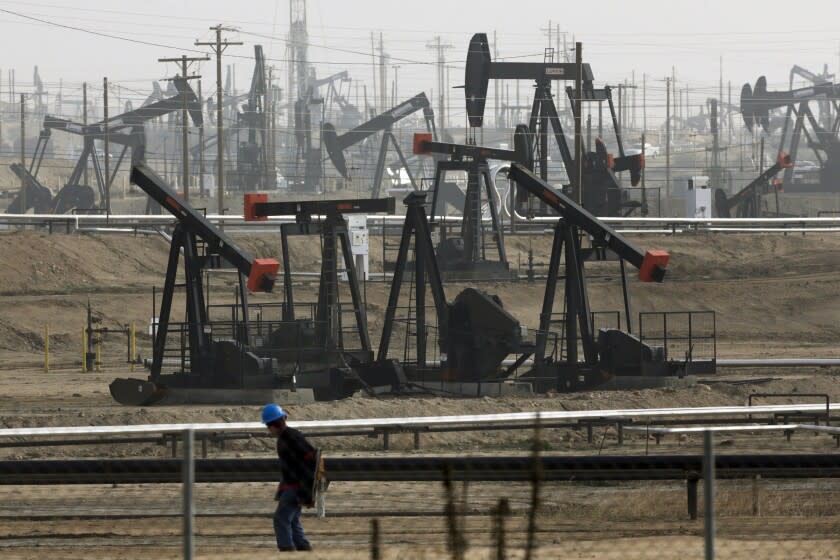Editorial: Goodbye fossil fuels. California should commit to going carbon neutral by 2045

- Oops!Something went wrong.Please try again later.
Last month, the United Nations issued a dire warning: It’s too late to stop the effects of global warming, which are fueling record-breaking heat waves, flooding and wildfires. But by dramatically reducing the use of fossil fuels starting now and zeroing out planet-warming gases by the midcentury, the report noted, the world could prevent greater devastation.
In theory, California is already moving in that direction. The state has committed to cutting greenhouse gas emissions by 40% by 2030. And then-Gov. Jerry Brown signed an executive order in 2018 setting the goal even higher: carbon neutrality by 2045, meaning the state would remove as much carbon dioxide from the atmosphere as it emits.
However, the pledge to go carbon neutral is only aspirational at this point. It’s an executive order without the force of law. An important bill pending in the Legislature would change that. Assembly Bill 1395 by Assembly members Al Muratsuchi (D-Torrance) and Cristina Garcia (D-Bell Gardens) would codify Brown’s executive order into law. That’s an ambitious but necessary step for the state, which is one of the world’s leaders on climate change policy.
California has already committed to 100% clean energy by 2045. But electrical power generation is responsible for only about 15% of the state’s greenhouse gas emissions. By going carbon neutral, California is committing to slash emissions from everything else, including cars and trucks, home heating and cooking, farms and industrial operations.
Specifically, AB 1395 would direct the state to reduce greenhouse gas emissions by 90% below 1990 levels by 2045. That would likely mean phasing out gas- and diesel-fueled cars and trucks in favor of zero-emission vehicles; reducing or eliminating natural gas in homes and businesses; ending oil and gas extraction; and cutting methane emissions from oil wells, landfills and farms.
For the emissions that cannot be eliminated, the state would pursue technologies that capture carbon dioxide from industrial facilities and that remove existing carbon dioxide from the atmosphere. Some of these technologies are still being developed or don’t even exist yet. The bill would direct state agencies to ensure that carbon capture or removal projects don’t end up polluting the surrounding communities or pose a public health risk. That makes sense — in fighting climate change, we shouldn’t sacrifice local environmental protection.
There’s strong opposition to AB 1395 from the oil and gas sector, the agricultural industry and business groups. They argue the bill moves too fast and doesn’t consider the cost and feasibility of slashing greenhouse gas emissions and largely eliminating fossil fuels over the coming decades.
The reality is that California and the world must move fast if there is any hope of stopping climate catastrophe. Transitioning an entire economy from fossil fuels to clean technology will be challenging, time consuming and expensive for businesses and residents. But the cost of inaction is unthinkable. If we don’t accelerate the work now, it will be nearly impossible to zero out planet-warming emissions by the middle of the century.
Last week has brought fresh evidence that climate change is fueling more extreme weather events in California and beyond. The state is again facing unprecedented wildfires, like the Caldor Fire near Lake Tahoe that has forced thousands of people to evacuate their homes. Nearly 1 million people are without power and drinking water in Louisiana and Mississippi after a hurricane knocked out electrical lines. Heavy rain caused flooding in New York City’s subway system, along with roads and homes throughout the region.
The summer has already given us a terrible glimpse of the future if we don’t move aggressively now. California can continue to lead the fight against climate change by passing AB 1395.
This story originally appeared in Los Angeles Times.

